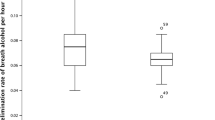Abstract
In German-speaking countries, blood ethanol concentrations (BECs) are usually calculated using Widmark’s equation. The distribution factor r of this equation is a correction factor needed to obtain a reduced body mass and corresponds to the ratio of total body water and blood water content. To enhance the reliability of Widmark’s model equation, the body weight, body height, blood water content and total body water of 256 women and 273 men were measured. The ratio of body water to blood water ranged from 0.44 to 0.80 in women and from 0.60 to 0.87 in men. For both sexes equations were developed by multiple regression analysis which allow the determination of the individual, more realistic distribution factors rFI (for females) and rMI (for males) even when only body height and body weight are known. Drinking experiments revealed a clearly higher congruence of calculated and measured blood ethanol concentrations when rFI or rMI were used instead of rigid distribution factors, i.e. 0.6 for women and 0.7 for men with or without the assumption of a 10% so-called resorption deficit. Additionally, Widmark’s equation in combination with rFI or rMI allows a more accurate prediction of blood ethanol concentrations than the equations of Watson and Ulrich.
Similar content being viewed by others
Author information
Authors and Affiliations
Additional information
Received: 25 October 1999 / Accepted: 17 March 2000
Rights and permissions
About this article
Cite this article
Seidl, S., Jensen, U. & Alt, A. The calculation of blood ethanol concentrations in males and females. Int J Leg Med 114, 71–77 (2000). https://doi.org/10.1007/s004140000154
Issue Date:
DOI: https://doi.org/10.1007/s004140000154




